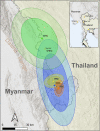Distance matters: barriers to antenatal care and safe childbirth in a migrant population on the Thailand-Myanmar border from 2007 to 2015, a pregnancy cohort study
- PMID: 34856954
- PMCID: PMC8638435
- DOI: 10.1186/s12884-021-04276-5
Distance matters: barriers to antenatal care and safe childbirth in a migrant population on the Thailand-Myanmar border from 2007 to 2015, a pregnancy cohort study
Abstract
Background: Antenatal care and skilled childbirth services are important interventions to improve maternal health and lower the risk of poor pregnancy outcomes and mortality. A growing body of literature has shown that geographic distance to clinics can be a disincentive towards seeking care during pregnancy. On the Thailand-Myanmar border antenatal clinics serving migrant populations have found high rates of loss to follow-up of 17.4%, but decades of civil conflict have made the underlying factors difficult to investigate. Here we perform a comprehensive study examining the geographic, demographic, and health-related factors contributing to loss to follow-up.
Methods: Using patient records we conducted a spatial and epidemiological analysis looking for predictors of loss to follow-up and pregnancy outcomes between 2007 and 2015. We used multivariable negative binomial regressions to assess for associations between distance travelled to the clinic and birth outcomes (loss to follow-up, pregnancy complications, and time of first presentation for antenatal care.) RESULTS: We found distance travelled to clinic strongly predicts loss to follow-up, miscarriage, malaria infections in pregnancy, and presentation for antenatal care after the first trimester. People lost to follow-up travelled 50% farther than people who had a normal singleton childbirth (a ratio of distances (DR) 1.5; 95% confidence interval (CI): 1.4 - 1.5). People with pregnancies complicated by miscarriage travelled 20% farther than those who did not have miscarriages (DR: 1.2; CI 1.1-1.3), and those with Plasmodium falciparum malaria in pregnancy travelled 60% farther than those without P. falciparum (DR: 1.6; CI: 1.6 - 1.8). People who delayed antenatal care until the third trimester travelled 50% farther compared to people who attended in the first trimester (DR: 1.5; CI: 1.4 - 1.5).
Conclusions: This analysis provides the first evidence of the complex impact of geography on access to antenatal services and pregnancy outcomes in the rural, remote, and politically complex Thailand-Myanmar border region. These findings can be used to help guide evidence-based interventions to increase uptake of maternal healthcare both in the Thailand-Myanmar region and in other rural, remote, and politically complicated environments.
Keywords: Access to care; Geography; Healthcare delivery; Malaria; Maternal health; Pregnancy; Prenatal care.
© 2021. The Author(s).
Conflict of interest statement
The authors declare that we have no competing interests.
Figures


Similar articles
-
COVID-19 pandemic, pregnancy care, perinatal outcomes in Eastern Myanmar and North-Western Thailand: a retrospective marginalised population cohort.BMC Pregnancy Childbirth. 2024 Oct 2;24(1):637. doi: 10.1186/s12884-024-06841-0. BMC Pregnancy Childbirth. 2024. PMID: 39358743 Free PMC article.
-
Giving birth on the way to the clinic: undocumented migrant women's perceptions and experiences of maternal healthcare accessibility along the Thailand-Myanmar border.Reprod Health. 2023 Dec 6;20(1):178. doi: 10.1186/s12978-023-01722-9. Reprod Health. 2023. PMID: 38057915 Free PMC article.
-
Migrant and Refugee Patient Perspectives on Travel and Tuberculosis along the Thailand-Myanmar Border: A Qualitative Study.PLoS One. 2016 Aug 10;11(8):e0160222. doi: 10.1371/journal.pone.0160222. eCollection 2016. PLoS One. 2016. PMID: 27509036 Free PMC article.
-
Including undocumented migrants in universal health coverage: a maternal health case study from the Thailand-Myanmar border.BMC Health Serv Res. 2021 Dec 7;21(1):1315. doi: 10.1186/s12913-021-07325-z. BMC Health Serv Res. 2021. PMID: 34876107 Free PMC article.
-
Access to community-based reproductive health services and incidence of low birthweight delivery among refugee and displaced mothers: a retrospective study in the Thailand-Myanmar border region.BMJ Open. 2022 Jan 31;12(1):e052571. doi: 10.1136/bmjopen-2021-052571. BMJ Open. 2022. PMID: 35105627 Free PMC article.
Cited by
-
COVID-19 pandemic, pregnancy care, perinatal outcomes in Eastern Myanmar and North-Western Thailand: a retrospective marginalised population cohort.BMC Pregnancy Childbirth. 2024 Oct 2;24(1):637. doi: 10.1186/s12884-024-06841-0. BMC Pregnancy Childbirth. 2024. PMID: 39358743 Free PMC article.
-
Giving birth on the way to the clinic: undocumented migrant women's perceptions and experiences of maternal healthcare accessibility along the Thailand-Myanmar border.Reprod Health. 2023 Dec 6;20(1):178. doi: 10.1186/s12978-023-01722-9. Reprod Health. 2023. PMID: 38057915 Free PMC article.
-
Loss to Hospital Follow-Up in Pediatric Cerebral Malaria Survivors: A Case-Control Study.Am J Trop Med Hyg. 2023 Sep 25;109(5):1077-1080. doi: 10.4269/ajtmh.23-0403. Print 2023 Nov 1. Am J Trop Med Hyg. 2023. PMID: 37748770 Free PMC article.
-
Availability and readiness of healthcare facilities and their effects on antenatal care services uptake in Bangladesh.BMC Health Serv Res. 2024 Apr 5;24(1):431. doi: 10.1186/s12913-024-10824-4. BMC Health Serv Res. 2024. PMID: 38575980 Free PMC article.
-
Born too soon in a resource-limited setting: A 10-year mixed methods review of a special care baby unit for refugees and migrants on the Myanmar-Thailand border.Front Public Health. 2023 Apr 12;11:1144642. doi: 10.3389/fpubh.2023.1144642. eCollection 2023. Front Public Health. 2023. PMID: 37124770 Free PMC article.
References
-
- World Health Organization . WHO recommendations on antenatal care for a positive pregnancy experience. World Health Organization; 2016. - PubMed
-
- Organization WH . Defining competent maternal and newborn health professionals: background document to the 2018 joint statement by WHO, UNFPA, UNICEF, ICM, ICN, FIGO and IPA: definition of skilled health personnel providing care during childbirth. World Health Organization; 2018.

